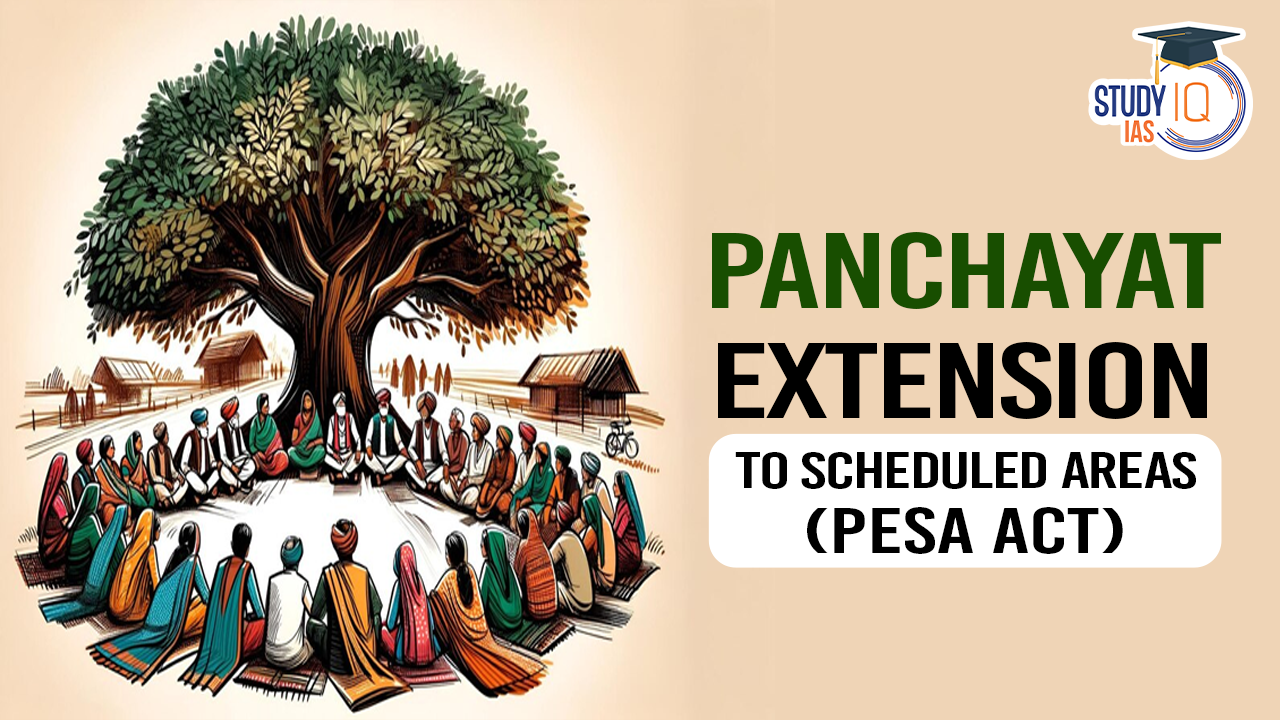Table of Contents
Context
- Political representation for marginalised communities can boost forest conservation and secure economic interests.
- They advocate for decentralisation and democratisation, giving local communities actual decision-making power in resource management.
Background of PESA Act 1996
- India’s conservation policy has struggled with balancing conservation, resource extraction by local communities, and economic development.
- The state’s approach has been inconsistent, influenced by political competition at national, state, and local levels.
- Centralization of political power tends to favour the interests of big capital, leading to deforestation for mining, power projects, and other commercial activities.
- Conservation initiatives often follow a top-down approach, limiting local communities’ access to traditional forest lands.
About PESA Act 1996
Purpose
- The Panchayats Extension to Scheduled Areas (PESA) Act 1996 was enacted to provide for the extension of the provisions of Part IX of the Constitution relating to the Panchayats to the Scheduled Areas”.
- Enacted on 24 December 1996, the Act aimed to enable tribal self-rule in 5th Schedule areas by extending the provisions of Panchayats to these tribal regions.
Historical Context
- Tribal communities in India have historically faced marginalisation, exclusion from mainstream political and economic systems, displacement, loss of land and resources, and cultural erosion.
- PESA drew inspiration from the 73rd and 74th amendments of the Indian Constitution, aiming to provide greater autonomy to Scheduled areas, predominantly inhabited by tribal populations, and protect their rights over land and forests.
Key Features
- PESA extends local government councils to Scheduled Areas with predominantly tribal populations, requiring ST representation in local government councils.
- The Act grants special powers to Gram Sabhas in Scheduled Areas, particularly for managing natural resources.
- The primary goal is to prevent the exploitation of the tribal population through the active involvement of the Gram Sabha.
Significant Provisions of the PESA Act
- Gram Sabha:
- Establishes the Gram Sabha as a forum for community participation in the development process.
- Responsible for identifying development projects, preparing development plans, and implementing these plans.
- Village-Level Institutions:
- Provides for the establishment of village-level institutions to carry out development activities and provide basic services.
- These institutions include the Gram Panchayat, Gram Sabha, and Panchayat Samiti.
- Powers and Functions: Grants significant powers and functions to the Gram Sabha and Gram Panchayat regarding the management of natural resources, environmental protection, and regulation of economic activities.
- Consultation: Requires consultation with the Gram Sabha before undertaking any development projects or activities in the Scheduled Areas.
- Funds: Allows for the transfer of funds to the Gram Sabha and Gram Panchayat to enable them to perform their functions.
- Land Rights:
- Provides protection for the land rights of tribal communities in Scheduled Areas.
- Requires obtaining consent from tribal communities before any land is acquired or transferred.
- Cultural and Social Practices:
- Protects the cultural and social practices of tribal communities in Scheduled Areas.
- Prohibits interference in these cultural and social practices.
Recent Key Findings on the PESA Act
- Mandated ST Representation and Forest Conservation:
- Mandated political representation for Scheduled Tribes (STs) leads to an average annual increase in tree canopy by 3% and a reduction in deforestation rates.
- These positive effects are more pronounced in areas with greater initial forest cover.
- Improvements in forest cover were observed only after the introduction of PESA elections with ST quotas.
- Economic Incentives and Forest Stewardship:
- Empowered ST communities, having economic incentives tied to non-timber forest produce and caloric intake, are motivated to protect forests.
- This economic dependency makes them oppose commercial timber and mining activities, which are significant drivers of deforestation.
- The concept of “forest stewardship” highlights how STs, when given political power, can align their economic interests with forest conservation.
- Opposition to Mining Interests:
- Increased ST representation enables communities to resist mining and other large-scale commercial operations.
- Areas close to mines experienced higher deforestation rates before PESA, but the introduction of PESA elections led to a significant reduction in deforestation in these regions.
- The study also observed increased conflicts around mining post-PESA, indicating active resistance by ST communities.
- Comparison with FRA:
- The Scheduled Tribes and Other Traditional Forest Dwellers (Recognition of Forest Rights) Act, 2006 (FRA), showed no additional conservation impact beyond what was achieved by PESA.
| Related Information |
Census, 2011
Important Committees/Commissions:
|


 Delimitation: Issues, Legal and Constitu...
Delimitation: Issues, Legal and Constitu...
 SAMARTH Udyog Bharat 4.0: Transforming I...
SAMARTH Udyog Bharat 4.0: Transforming I...
 BHIM 3.0 Launched by NPCI: Key Features,...
BHIM 3.0 Launched by NPCI: Key Features,...





















